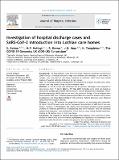Files in this item
Investigation of hospital discharge cases and SARS-CoV-2 introduction into Lothian care homes
Item metadata
| dc.contributor.author | Cotton, S | |
| dc.contributor.author | McHugh, M P | |
| dc.contributor.author | Dewar, R | |
| dc.contributor.author | Haas, J G | |
| dc.contributor.author | Templeton, K | |
| dc.contributor.author | COVID-19 Genomics UK (COG-UK) consortium | |
| dc.date.accessioned | 2023-04-05T11:30:08Z | |
| dc.date.available | 2023-04-05T11:30:08Z | |
| dc.date.issued | 2023-05-01 | |
| dc.identifier | 283995889 | |
| dc.identifier | 59fc66b3-faf4-414b-bdf4-690b76da137b | |
| dc.identifier | 36906180 | |
| dc.identifier | 85151248667 | |
| dc.identifier.citation | Cotton , S , McHugh , M P , Dewar , R , Haas , J G , Templeton , K & COVID-19 Genomics UK (COG-UK) consortium 2023 , ' Investigation of hospital discharge cases and SARS-CoV-2 introduction into Lothian care homes ' , Journal of Hospital Infection , vol. 135 , pp. 28-36 . https://doi.org/10.1016/j.jhin.2023.02.010 | en |
| dc.identifier.issn | 0195-6701 | |
| dc.identifier.other | Jisc: 980224 | |
| dc.identifier.other | pmc: PMC9997060 | |
| dc.identifier.other | pii: S0195-6701(23)00067-1 | |
| dc.identifier.other | ORCID: /0000-0002-0370-3700/work/132764490 | |
| dc.identifier.uri | https://hdl.handle.net/10023/27342 | |
| dc.description | COG-UK is supported by funding from the MRC part of UK Research & Innovation, the National Institute of Health Research (Grant code MC_PC_19027), and Genome Research Limited, operating as the Welcome Sanger Institute. | en |
| dc.description.abstract | Background The first epidemic wave of severe acute respiratory syndrome coronavirus-2 (SARS-CoV-2) in Scotland resulted in high case numbers and mortality in care homes. In Lothian, over one-third of care homes reported an outbreak, while there was limited testing of hospital patients discharged to care homes. Aim To investigate patients discharged from hospitals as a source of SARS-CoV-2 introduction into care homes during the first epidemic wave. Methods A clinical review was performed for all patients discharges from hospitals to care homes from 1st March 2020 to 31st May 2020. Episodes were ruled out based on coronavirus disease 2019 (COVID-19) test history, clinical assessment at discharge, whole-genome sequencing (WGS) data and an infectious period of 14 days. Clinical samples were processed for WGS, and consensus genomes generated were used for analysis using Cluster Investigation and Virus Epidemiological Tool software. Patient timelines were obtained using electronic hospital records. Findings In total, 787 patients discharged from hospitals to care homes were identified. Of these, 776 (99%) were ruled out for subsequent introduction of SARS-CoV-2 into care homes. However, for 10 episodes, the results were inconclusive as there was low genomic diversity in consensus genomes or no sequencing data were available. Only one discharge episode had a genomic, time and location link to positive cases during hospital admission, leading to 10 positive cases in their care home. Conclusion The majority of patients discharged from hospitals were ruled out for introduction of SARS-CoV-2 into care homes, highlighting the importance of screening all new admissions when faced with a novel emerging virus and no available vaccine. | |
| dc.format.extent | 9 | |
| dc.format.extent | 455704 | |
| dc.language.iso | eng | |
| dc.relation.ispartof | Journal of Hospital Infection | en |
| dc.subject | Hospital discharge | en |
| dc.subject | Introduction | en |
| dc.subject | SARS-CoV-2 | en |
| dc.subject | Care homes | en |
| dc.subject | RA0421 Public health. Hygiene. Preventive Medicine | en |
| dc.subject | NDAS | en |
| dc.subject | SDG 3 - Good Health and Well-being | en |
| dc.subject | NIS | en |
| dc.subject | MCC | en |
| dc.subject.lcc | RA0421 | en |
| dc.title | Investigation of hospital discharge cases and SARS-CoV-2 introduction into Lothian care homes | en |
| dc.type | Journal article | en |
| dc.contributor.institution | University of St Andrews. School of Medicine | en |
| dc.contributor.institution | University of St Andrews. Infection and Global Health Division | en |
| dc.identifier.doi | 10.1016/j.jhin.2023.02.010 | |
| dc.description.status | Peer reviewed | en |
This item appears in the following Collection(s)
Items in the St Andrews Research Repository are protected by copyright, with all rights reserved, unless otherwise indicated.

